Analysis of Customer Lifecycle Methodology in Business Analytics
VerifiedAdded on 2023/03/31
|7
|1971
|418
Report
AI Summary
This report provides a comprehensive analysis of customer lifecycle methodology within the context of business analytics. It begins with an executive summary and an introduction highlighting the significance of integrating customer lifecycle management with business analytics to enhance performance and service delivery. The report defines customer lifecycle and business analytics, emphasizing their combined role in understanding customer behavior and driving business growth. It then details a six-stage customer lifecycle methodology, including awareness, conversion, purchase, activation, renewal, and referral. The report discusses how to implement advanced business analytics within the customer lifecycle, covering non-technical challenges and customer profiling/segmentation. It explores the application of business analytics in customer acquisition, upselling, service, and retention. The conclusion underscores the importance of a holistic approach to customer lifecycle management and the value of business analytics in acquiring and retaining customers, ultimately aiming to prevent customer churn and improve overall business outcomes. References are also included for further reading.
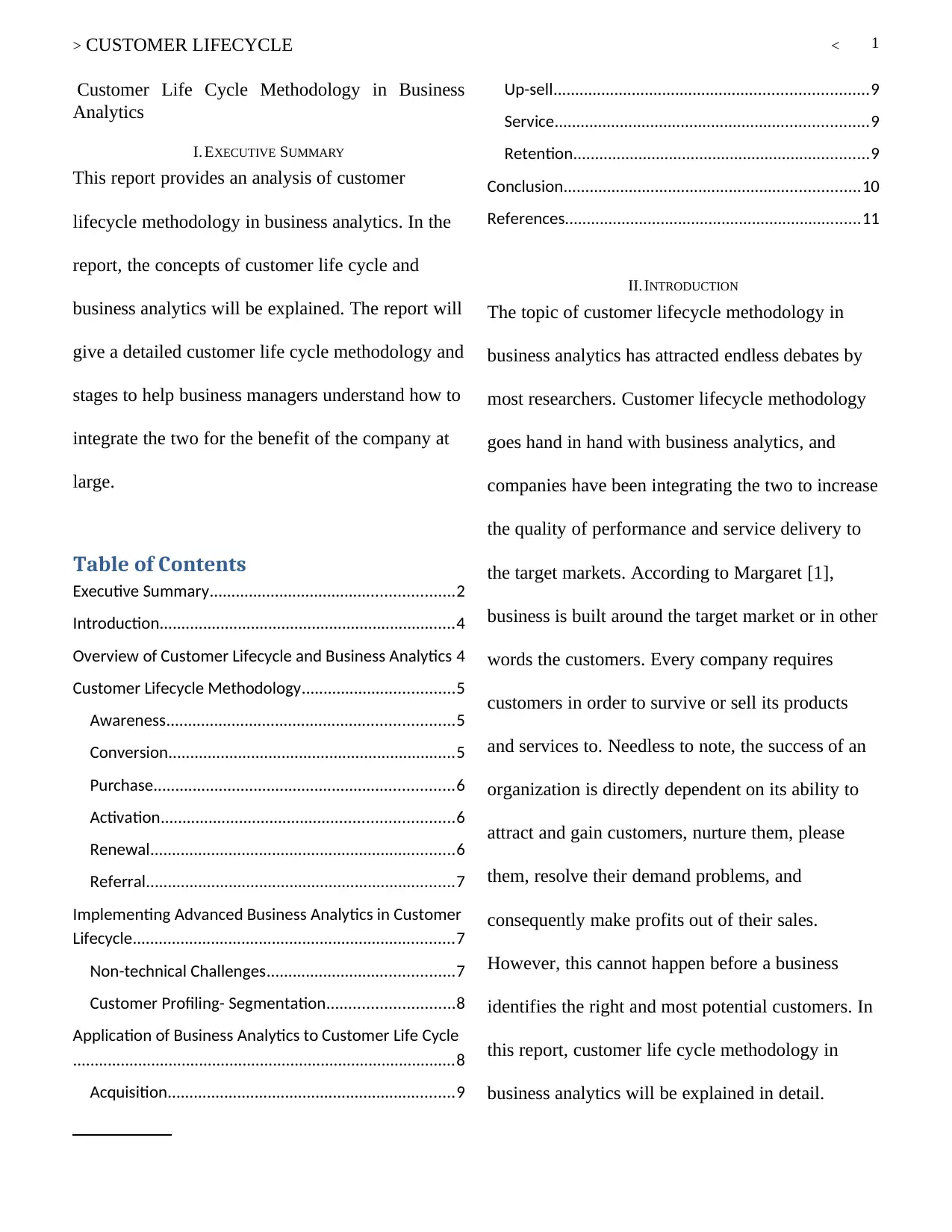
> CUSTOMER LIFECYCLE <
Customer Life Cycle Methodology in Business
Analytics
I. EXECUTIVE SUMMARY
This report provides an analysis of customer
lifecycle methodology in business analytics. In the
report, the concepts of customer life cycle and
business analytics will be explained. The report will
give a detailed customer life cycle methodology and
stages to help business managers understand how to
integrate the two for the benefit of the company at
large.
Table of Contents
Executive Summary........................................................2
Introduction....................................................................4
Overview of Customer Lifecycle and Business Analytics 4
Customer Lifecycle Methodology...................................5
Awareness..................................................................5
Conversion..................................................................5
Purchase.....................................................................6
Activation...................................................................6
Renewal......................................................................6
Referral.......................................................................7
Implementing Advanced Business Analytics in Customer
Lifecycle..........................................................................7
Non-technical Challenges...........................................7
Customer Profiling- Segmentation.............................8
Application of Business Analytics to Customer Life Cycle
........................................................................................8
Acquisition..................................................................9
Up-sell........................................................................9
Service........................................................................9
Retention....................................................................9
Conclusion....................................................................10
References....................................................................11
II.INTRODUCTION
The topic of customer lifecycle methodology in
business analytics has attracted endless debates by
most researchers. Customer lifecycle methodology
goes hand in hand with business analytics, and
companies have been integrating the two to increase
the quality of performance and service delivery to
the target markets. According to Margaret [1],
business is built around the target market or in other
words the customers. Every company requires
customers in order to survive or sell its products
and services to. Needless to note, the success of an
organization is directly dependent on its ability to
attract and gain customers, nurture them, please
them, resolve their demand problems, and
consequently make profits out of their sales.
However, this cannot happen before a business
identifies the right and most potential customers. In
this report, customer life cycle methodology in
business analytics will be explained in detail.
1
Customer Life Cycle Methodology in Business
Analytics
I. EXECUTIVE SUMMARY
This report provides an analysis of customer
lifecycle methodology in business analytics. In the
report, the concepts of customer life cycle and
business analytics will be explained. The report will
give a detailed customer life cycle methodology and
stages to help business managers understand how to
integrate the two for the benefit of the company at
large.
Table of Contents
Executive Summary........................................................2
Introduction....................................................................4
Overview of Customer Lifecycle and Business Analytics 4
Customer Lifecycle Methodology...................................5
Awareness..................................................................5
Conversion..................................................................5
Purchase.....................................................................6
Activation...................................................................6
Renewal......................................................................6
Referral.......................................................................7
Implementing Advanced Business Analytics in Customer
Lifecycle..........................................................................7
Non-technical Challenges...........................................7
Customer Profiling- Segmentation.............................8
Application of Business Analytics to Customer Life Cycle
........................................................................................8
Acquisition..................................................................9
Up-sell........................................................................9
Service........................................................................9
Retention....................................................................9
Conclusion....................................................................10
References....................................................................11
II.INTRODUCTION
The topic of customer lifecycle methodology in
business analytics has attracted endless debates by
most researchers. Customer lifecycle methodology
goes hand in hand with business analytics, and
companies have been integrating the two to increase
the quality of performance and service delivery to
the target markets. According to Margaret [1],
business is built around the target market or in other
words the customers. Every company requires
customers in order to survive or sell its products
and services to. Needless to note, the success of an
organization is directly dependent on its ability to
attract and gain customers, nurture them, please
them, resolve their demand problems, and
consequently make profits out of their sales.
However, this cannot happen before a business
identifies the right and most potential customers. In
this report, customer life cycle methodology in
business analytics will be explained in detail.
1
Paraphrase This Document
Need a fresh take? Get an instant paraphrase of this document with our AI Paraphraser
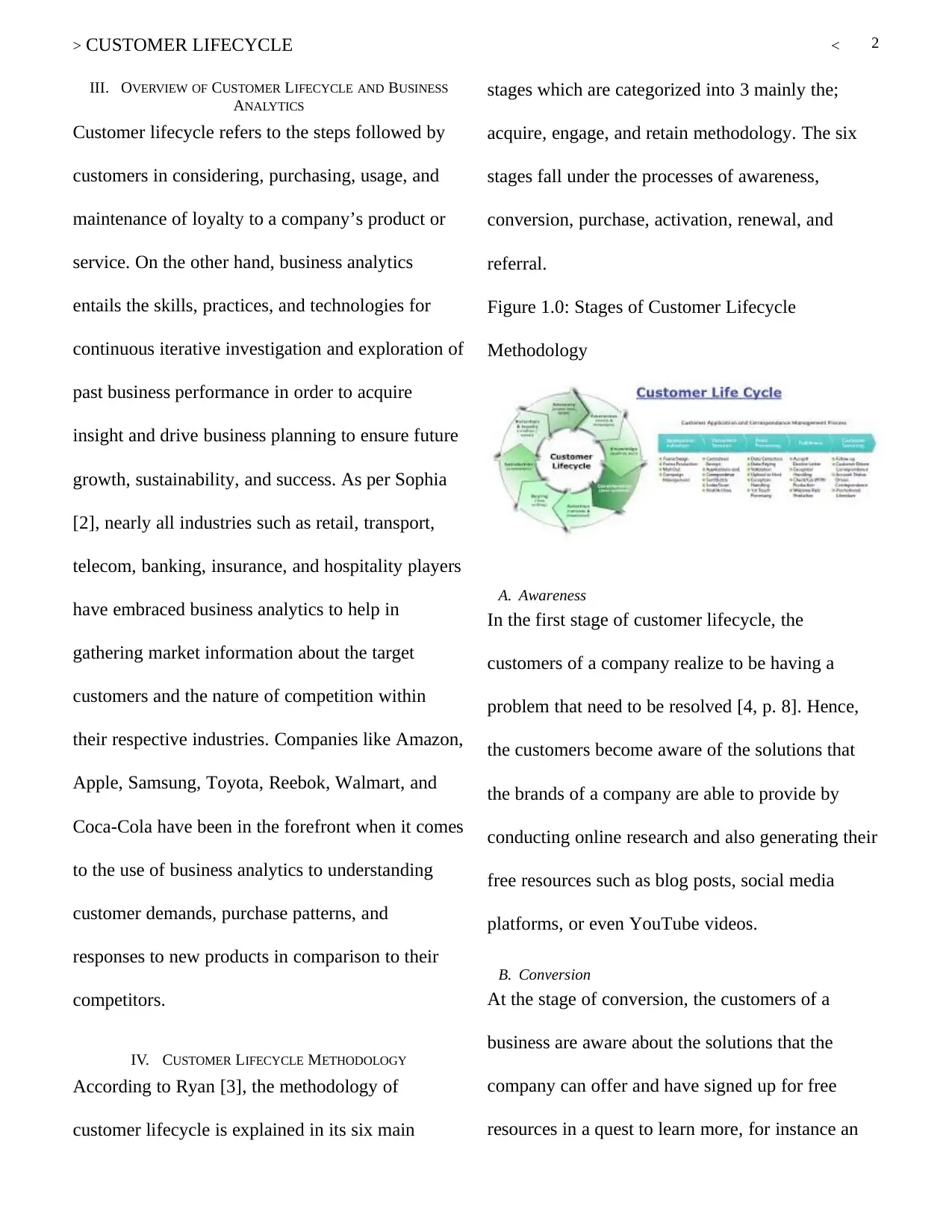
> CUSTOMER LIFECYCLE <
III. OVERVIEW OF CUSTOMER LIFECYCLE AND BUSINESS
ANALYTICS
Customer lifecycle refers to the steps followed by
customers in considering, purchasing, usage, and
maintenance of loyalty to a company’s product or
service. On the other hand, business analytics
entails the skills, practices, and technologies for
continuous iterative investigation and exploration of
past business performance in order to acquire
insight and drive business planning to ensure future
growth, sustainability, and success. As per Sophia
[2], nearly all industries such as retail, transport,
telecom, banking, insurance, and hospitality players
have embraced business analytics to help in
gathering market information about the target
customers and the nature of competition within
their respective industries. Companies like Amazon,
Apple, Samsung, Toyota, Reebok, Walmart, and
Coca-Cola have been in the forefront when it comes
to the use of business analytics to understanding
customer demands, purchase patterns, and
responses to new products in comparison to their
competitors.
IV. CUSTOMER LIFECYCLE METHODOLOGY
According to Ryan [3], the methodology of
customer lifecycle is explained in its six main
stages which are categorized into 3 mainly the;
acquire, engage, and retain methodology. The six
stages fall under the processes of awareness,
conversion, purchase, activation, renewal, and
referral.
Figure 1.0: Stages of Customer Lifecycle
Methodology
A. Awareness
In the first stage of customer lifecycle, the
customers of a company realize to be having a
problem that need to be resolved [4, p. 8]. Hence,
the customers become aware of the solutions that
the brands of a company are able to provide by
conducting online research and also generating their
free resources such as blog posts, social media
platforms, or even YouTube videos.
B. Conversion
At the stage of conversion, the customers of a
business are aware about the solutions that the
company can offer and have signed up for free
resources in a quest to learn more, for instance an
2
III. OVERVIEW OF CUSTOMER LIFECYCLE AND BUSINESS
ANALYTICS
Customer lifecycle refers to the steps followed by
customers in considering, purchasing, usage, and
maintenance of loyalty to a company’s product or
service. On the other hand, business analytics
entails the skills, practices, and technologies for
continuous iterative investigation and exploration of
past business performance in order to acquire
insight and drive business planning to ensure future
growth, sustainability, and success. As per Sophia
[2], nearly all industries such as retail, transport,
telecom, banking, insurance, and hospitality players
have embraced business analytics to help in
gathering market information about the target
customers and the nature of competition within
their respective industries. Companies like Amazon,
Apple, Samsung, Toyota, Reebok, Walmart, and
Coca-Cola have been in the forefront when it comes
to the use of business analytics to understanding
customer demands, purchase patterns, and
responses to new products in comparison to their
competitors.
IV. CUSTOMER LIFECYCLE METHODOLOGY
According to Ryan [3], the methodology of
customer lifecycle is explained in its six main
stages which are categorized into 3 mainly the;
acquire, engage, and retain methodology. The six
stages fall under the processes of awareness,
conversion, purchase, activation, renewal, and
referral.
Figure 1.0: Stages of Customer Lifecycle
Methodology
A. Awareness
In the first stage of customer lifecycle, the
customers of a company realize to be having a
problem that need to be resolved [4, p. 8]. Hence,
the customers become aware of the solutions that
the brands of a company are able to provide by
conducting online research and also generating their
free resources such as blog posts, social media
platforms, or even YouTube videos.
B. Conversion
At the stage of conversion, the customers of a
business are aware about the solutions that the
company can offer and have signed up for free
resources in a quest to learn more, for instance an
2
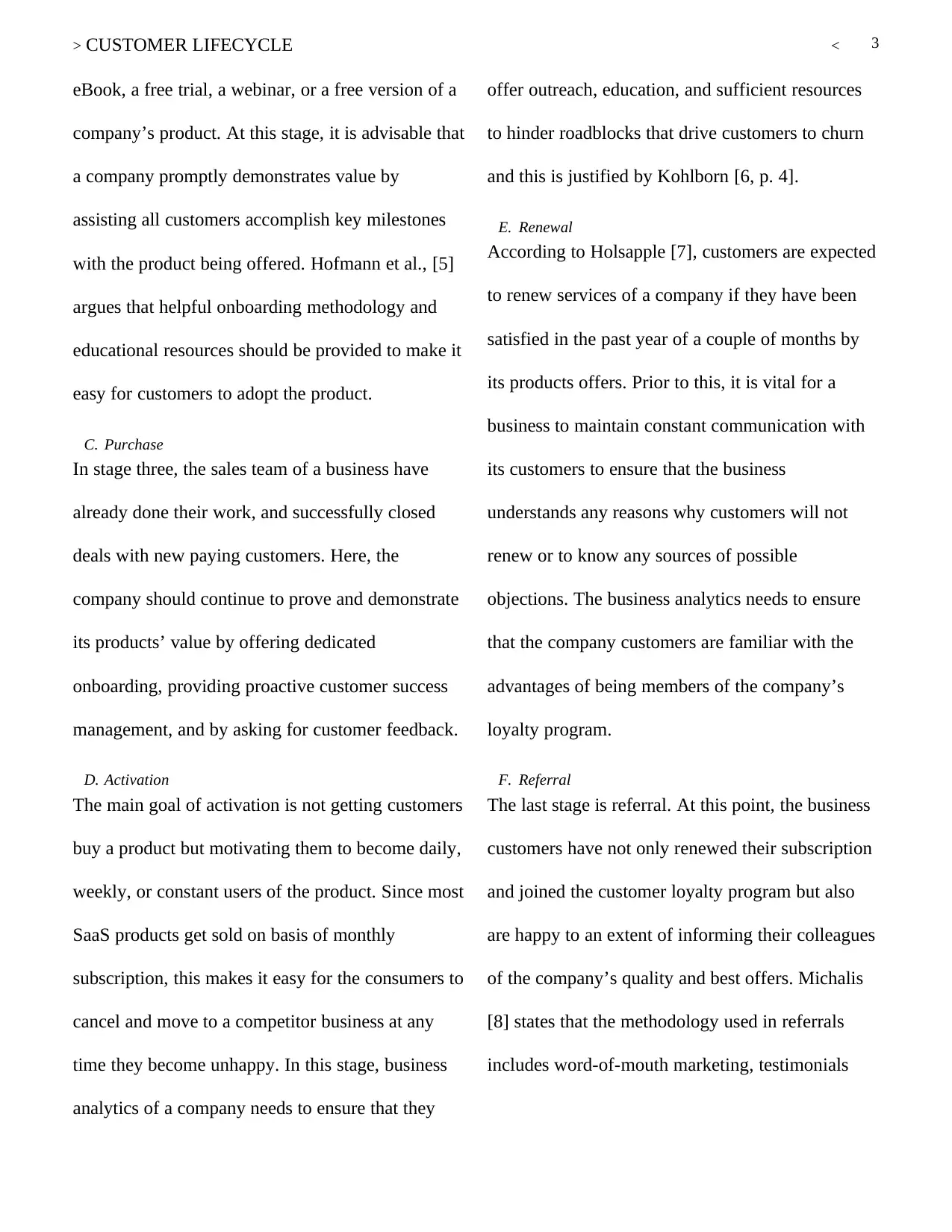
> CUSTOMER LIFECYCLE <
eBook, a free trial, a webinar, or a free version of a
company’s product. At this stage, it is advisable that
a company promptly demonstrates value by
assisting all customers accomplish key milestones
with the product being offered. Hofmann et al., [5]
argues that helpful onboarding methodology and
educational resources should be provided to make it
easy for customers to adopt the product.
C. Purchase
In stage three, the sales team of a business have
already done their work, and successfully closed
deals with new paying customers. Here, the
company should continue to prove and demonstrate
its products’ value by offering dedicated
onboarding, providing proactive customer success
management, and by asking for customer feedback.
D. Activation
The main goal of activation is not getting customers
buy a product but motivating them to become daily,
weekly, or constant users of the product. Since most
SaaS products get sold on basis of monthly
subscription, this makes it easy for the consumers to
cancel and move to a competitor business at any
time they become unhappy. In this stage, business
analytics of a company needs to ensure that they
offer outreach, education, and sufficient resources
to hinder roadblocks that drive customers to churn
and this is justified by Kohlborn [6, p. 4].
E. Renewal
According to Holsapple [7], customers are expected
to renew services of a company if they have been
satisfied in the past year of a couple of months by
its products offers. Prior to this, it is vital for a
business to maintain constant communication with
its customers to ensure that the business
understands any reasons why customers will not
renew or to know any sources of possible
objections. The business analytics needs to ensure
that the company customers are familiar with the
advantages of being members of the company’s
loyalty program.
F. Referral
The last stage is referral. At this point, the business
customers have not only renewed their subscription
and joined the customer loyalty program but also
are happy to an extent of informing their colleagues
of the company’s quality and best offers. Michalis
[8] states that the methodology used in referrals
includes word-of-mouth marketing, testimonials
3
eBook, a free trial, a webinar, or a free version of a
company’s product. At this stage, it is advisable that
a company promptly demonstrates value by
assisting all customers accomplish key milestones
with the product being offered. Hofmann et al., [5]
argues that helpful onboarding methodology and
educational resources should be provided to make it
easy for customers to adopt the product.
C. Purchase
In stage three, the sales team of a business have
already done their work, and successfully closed
deals with new paying customers. Here, the
company should continue to prove and demonstrate
its products’ value by offering dedicated
onboarding, providing proactive customer success
management, and by asking for customer feedback.
D. Activation
The main goal of activation is not getting customers
buy a product but motivating them to become daily,
weekly, or constant users of the product. Since most
SaaS products get sold on basis of monthly
subscription, this makes it easy for the consumers to
cancel and move to a competitor business at any
time they become unhappy. In this stage, business
analytics of a company needs to ensure that they
offer outreach, education, and sufficient resources
to hinder roadblocks that drive customers to churn
and this is justified by Kohlborn [6, p. 4].
E. Renewal
According to Holsapple [7], customers are expected
to renew services of a company if they have been
satisfied in the past year of a couple of months by
its products offers. Prior to this, it is vital for a
business to maintain constant communication with
its customers to ensure that the business
understands any reasons why customers will not
renew or to know any sources of possible
objections. The business analytics needs to ensure
that the company customers are familiar with the
advantages of being members of the company’s
loyalty program.
F. Referral
The last stage is referral. At this point, the business
customers have not only renewed their subscription
and joined the customer loyalty program but also
are happy to an extent of informing their colleagues
of the company’s quality and best offers. Michalis
[8] states that the methodology used in referrals
includes word-of-mouth marketing, testimonials
3
⊘ This is a preview!⊘
Do you want full access?
Subscribe today to unlock all pages.

Trusted by 1+ million students worldwide
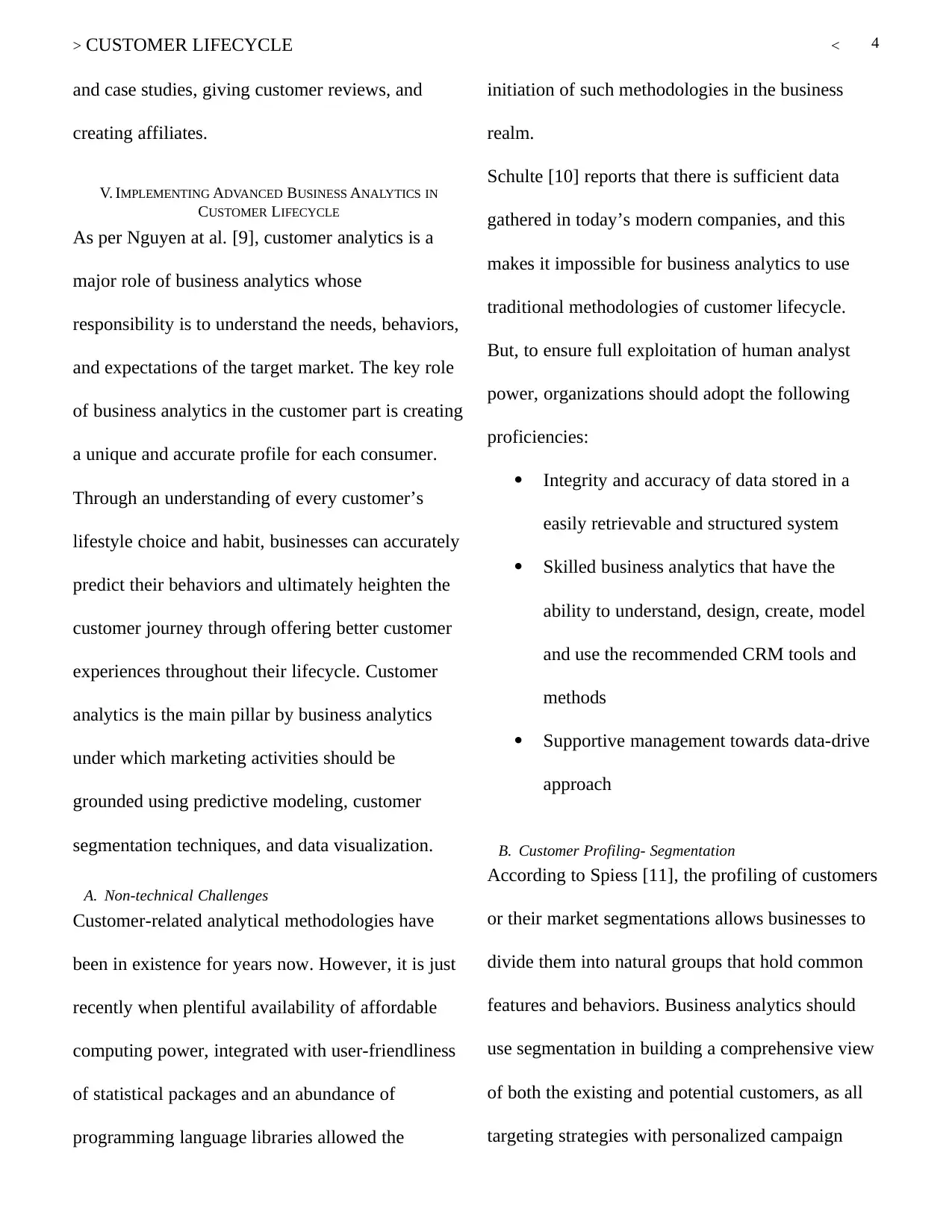
> CUSTOMER LIFECYCLE <
and case studies, giving customer reviews, and
creating affiliates.
V. IMPLEMENTING ADVANCED BUSINESS ANALYTICS IN
CUSTOMER LIFECYCLE
As per Nguyen at al. [9], customer analytics is a
major role of business analytics whose
responsibility is to understand the needs, behaviors,
and expectations of the target market. The key role
of business analytics in the customer part is creating
a unique and accurate profile for each consumer.
Through an understanding of every customer’s
lifestyle choice and habit, businesses can accurately
predict their behaviors and ultimately heighten the
customer journey through offering better customer
experiences throughout their lifecycle. Customer
analytics is the main pillar by business analytics
under which marketing activities should be
grounded using predictive modeling, customer
segmentation techniques, and data visualization.
A. Non-technical Challenges
Customer-related analytical methodologies have
been in existence for years now. However, it is just
recently when plentiful availability of affordable
computing power, integrated with user-friendliness
of statistical packages and an abundance of
programming language libraries allowed the
initiation of such methodologies in the business
realm.
Schulte [10] reports that there is sufficient data
gathered in today’s modern companies, and this
makes it impossible for business analytics to use
traditional methodologies of customer lifecycle.
But, to ensure full exploitation of human analyst
power, organizations should adopt the following
proficiencies:
Integrity and accuracy of data stored in a
easily retrievable and structured system
Skilled business analytics that have the
ability to understand, design, create, model
and use the recommended CRM tools and
methods
Supportive management towards data-drive
approach
B. Customer Profiling- Segmentation
According to Spiess [11], the profiling of customers
or their market segmentations allows businesses to
divide them into natural groups that hold common
features and behaviors. Business analytics should
use segmentation in building a comprehensive view
of both the existing and potential customers, as all
targeting strategies with personalized campaign
4
and case studies, giving customer reviews, and
creating affiliates.
V. IMPLEMENTING ADVANCED BUSINESS ANALYTICS IN
CUSTOMER LIFECYCLE
As per Nguyen at al. [9], customer analytics is a
major role of business analytics whose
responsibility is to understand the needs, behaviors,
and expectations of the target market. The key role
of business analytics in the customer part is creating
a unique and accurate profile for each consumer.
Through an understanding of every customer’s
lifestyle choice and habit, businesses can accurately
predict their behaviors and ultimately heighten the
customer journey through offering better customer
experiences throughout their lifecycle. Customer
analytics is the main pillar by business analytics
under which marketing activities should be
grounded using predictive modeling, customer
segmentation techniques, and data visualization.
A. Non-technical Challenges
Customer-related analytical methodologies have
been in existence for years now. However, it is just
recently when plentiful availability of affordable
computing power, integrated with user-friendliness
of statistical packages and an abundance of
programming language libraries allowed the
initiation of such methodologies in the business
realm.
Schulte [10] reports that there is sufficient data
gathered in today’s modern companies, and this
makes it impossible for business analytics to use
traditional methodologies of customer lifecycle.
But, to ensure full exploitation of human analyst
power, organizations should adopt the following
proficiencies:
Integrity and accuracy of data stored in a
easily retrievable and structured system
Skilled business analytics that have the
ability to understand, design, create, model
and use the recommended CRM tools and
methods
Supportive management towards data-drive
approach
B. Customer Profiling- Segmentation
According to Spiess [11], the profiling of customers
or their market segmentations allows businesses to
divide them into natural groups that hold common
features and behaviors. Business analytics should
use segmentation in building a comprehensive view
of both the existing and potential customers, as all
targeting strategies with personalized campaign
4
Paraphrase This Document
Need a fresh take? Get an instant paraphrase of this document with our AI Paraphraser
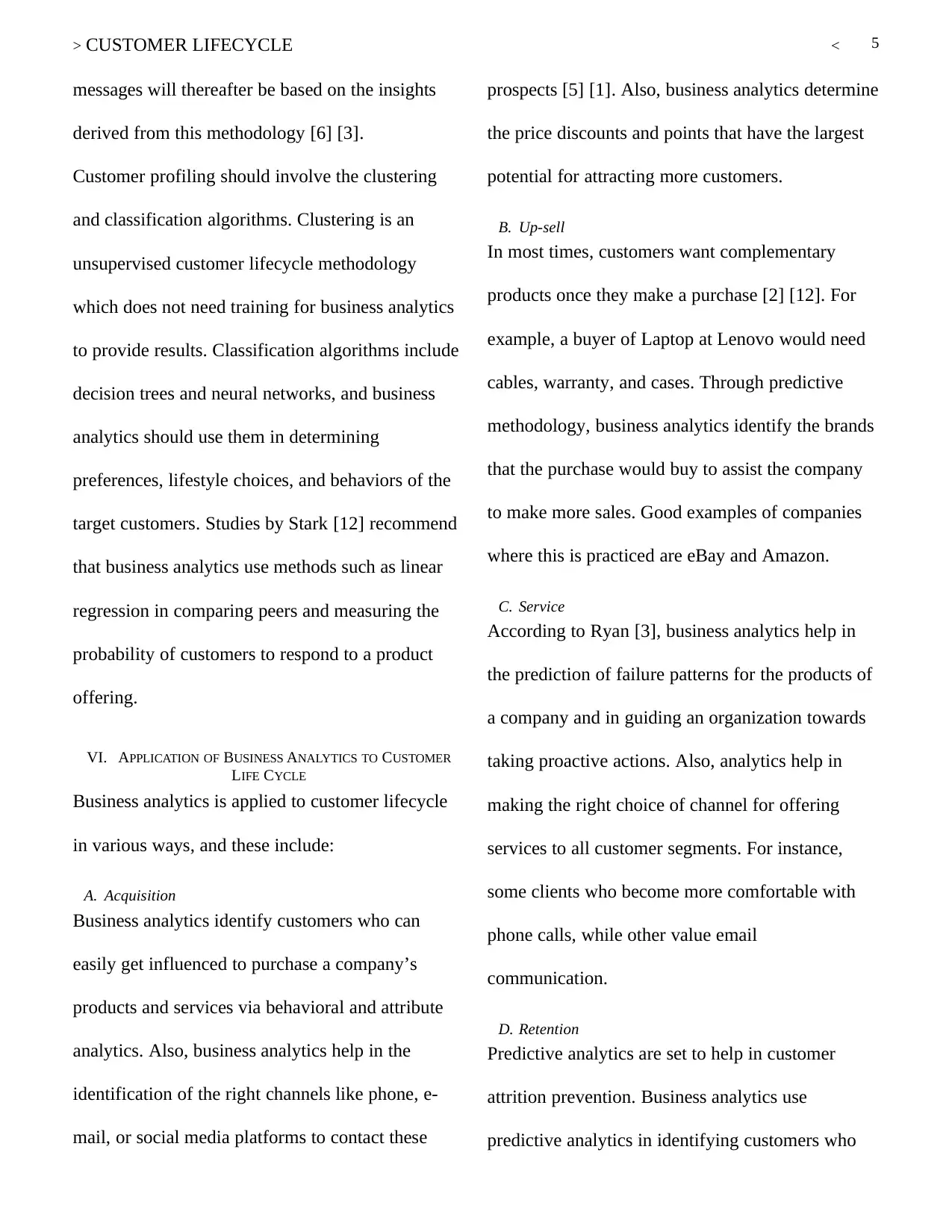
> CUSTOMER LIFECYCLE <
messages will thereafter be based on the insights
derived from this methodology [6] [3].
Customer profiling should involve the clustering
and classification algorithms. Clustering is an
unsupervised customer lifecycle methodology
which does not need training for business analytics
to provide results. Classification algorithms include
decision trees and neural networks, and business
analytics should use them in determining
preferences, lifestyle choices, and behaviors of the
target customers. Studies by Stark [12] recommend
that business analytics use methods such as linear
regression in comparing peers and measuring the
probability of customers to respond to a product
offering.
VI. APPLICATION OF BUSINESS ANALYTICS TO CUSTOMER
LIFE CYCLE
Business analytics is applied to customer lifecycle
in various ways, and these include:
A. Acquisition
Business analytics identify customers who can
easily get influenced to purchase a company’s
products and services via behavioral and attribute
analytics. Also, business analytics help in the
identification of the right channels like phone, e-
mail, or social media platforms to contact these
prospects [5] [1]. Also, business analytics determine
the price discounts and points that have the largest
potential for attracting more customers.
B. Up-sell
In most times, customers want complementary
products once they make a purchase [2] [12]. For
example, a buyer of Laptop at Lenovo would need
cables, warranty, and cases. Through predictive
methodology, business analytics identify the brands
that the purchase would buy to assist the company
to make more sales. Good examples of companies
where this is practiced are eBay and Amazon.
C. Service
According to Ryan [3], business analytics help in
the prediction of failure patterns for the products of
a company and in guiding an organization towards
taking proactive actions. Also, analytics help in
making the right choice of channel for offering
services to all customer segments. For instance,
some clients who become more comfortable with
phone calls, while other value email
communication.
D. Retention
Predictive analytics are set to help in customer
attrition prevention. Business analytics use
predictive analytics in identifying customers who
5
messages will thereafter be based on the insights
derived from this methodology [6] [3].
Customer profiling should involve the clustering
and classification algorithms. Clustering is an
unsupervised customer lifecycle methodology
which does not need training for business analytics
to provide results. Classification algorithms include
decision trees and neural networks, and business
analytics should use them in determining
preferences, lifestyle choices, and behaviors of the
target customers. Studies by Stark [12] recommend
that business analytics use methods such as linear
regression in comparing peers and measuring the
probability of customers to respond to a product
offering.
VI. APPLICATION OF BUSINESS ANALYTICS TO CUSTOMER
LIFE CYCLE
Business analytics is applied to customer lifecycle
in various ways, and these include:
A. Acquisition
Business analytics identify customers who can
easily get influenced to purchase a company’s
products and services via behavioral and attribute
analytics. Also, business analytics help in the
identification of the right channels like phone, e-
mail, or social media platforms to contact these
prospects [5] [1]. Also, business analytics determine
the price discounts and points that have the largest
potential for attracting more customers.
B. Up-sell
In most times, customers want complementary
products once they make a purchase [2] [12]. For
example, a buyer of Laptop at Lenovo would need
cables, warranty, and cases. Through predictive
methodology, business analytics identify the brands
that the purchase would buy to assist the company
to make more sales. Good examples of companies
where this is practiced are eBay and Amazon.
C. Service
According to Ryan [3], business analytics help in
the prediction of failure patterns for the products of
a company and in guiding an organization towards
taking proactive actions. Also, analytics help in
making the right choice of channel for offering
services to all customer segments. For instance,
some clients who become more comfortable with
phone calls, while other value email
communication.
D. Retention
Predictive analytics are set to help in customer
attrition prevention. Business analytics use
predictive analytics in identifying customers who
5
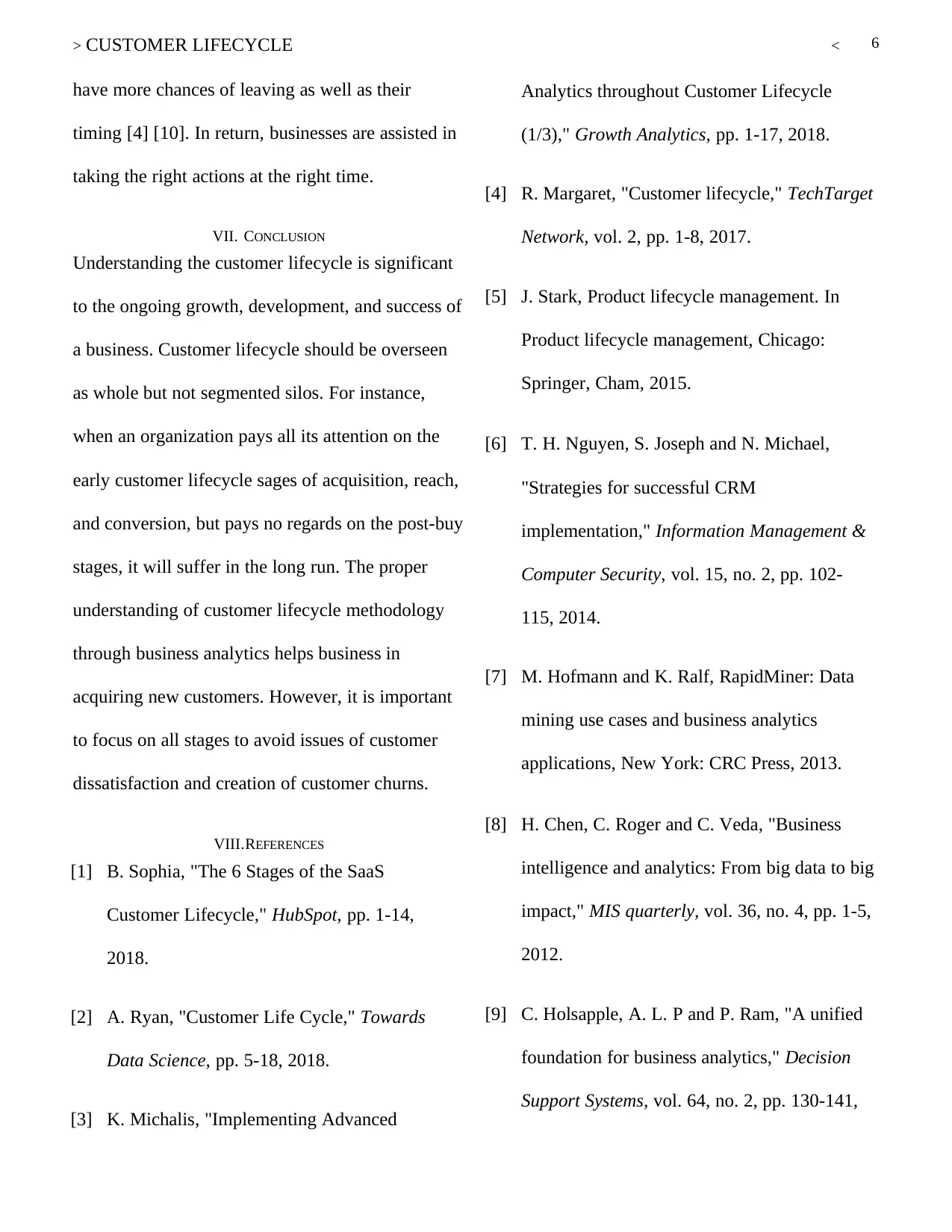
> CUSTOMER LIFECYCLE <
have more chances of leaving as well as their
timing [4] [10]. In return, businesses are assisted in
taking the right actions at the right time.
VII. CONCLUSION
Understanding the customer lifecycle is significant
to the ongoing growth, development, and success of
a business. Customer lifecycle should be overseen
as whole but not segmented silos. For instance,
when an organization pays all its attention on the
early customer lifecycle sages of acquisition, reach,
and conversion, but pays no regards on the post-buy
stages, it will suffer in the long run. The proper
understanding of customer lifecycle methodology
through business analytics helps business in
acquiring new customers. However, it is important
to focus on all stages to avoid issues of customer
dissatisfaction and creation of customer churns.
VIII.REFERENCES
[1] B. Sophia, "The 6 Stages of the SaaS
Customer Lifecycle," HubSpot, pp. 1-14,
2018.
[2] A. Ryan, "Customer Life Cycle," Towards
Data Science, pp. 5-18, 2018.
[3] K. Michalis, "Implementing Advanced
Analytics throughout Customer Lifecycle
(1/3)," Growth Analytics, pp. 1-17, 2018.
[4] R. Margaret, "Customer lifecycle," TechTarget
Network, vol. 2, pp. 1-8, 2017.
[5] J. Stark, Product lifecycle management. In
Product lifecycle management, Chicago:
Springer, Cham, 2015.
[6] T. H. Nguyen, S. Joseph and N. Michael,
"Strategies for successful CRM
implementation," Information Management &
Computer Security, vol. 15, no. 2, pp. 102-
115, 2014.
[7] M. Hofmann and K. Ralf, RapidMiner: Data
mining use cases and business analytics
applications, New York: CRC Press, 2013.
[8] H. Chen, C. Roger and C. Veda, "Business
intelligence and analytics: From big data to big
impact," MIS quarterly, vol. 36, no. 4, pp. 1-5,
2012.
[9] C. Holsapple, A. L. P and P. Ram, "A unified
foundation for business analytics," Decision
Support Systems, vol. 64, no. 2, pp. 130-141,
6
have more chances of leaving as well as their
timing [4] [10]. In return, businesses are assisted in
taking the right actions at the right time.
VII. CONCLUSION
Understanding the customer lifecycle is significant
to the ongoing growth, development, and success of
a business. Customer lifecycle should be overseen
as whole but not segmented silos. For instance,
when an organization pays all its attention on the
early customer lifecycle sages of acquisition, reach,
and conversion, but pays no regards on the post-buy
stages, it will suffer in the long run. The proper
understanding of customer lifecycle methodology
through business analytics helps business in
acquiring new customers. However, it is important
to focus on all stages to avoid issues of customer
dissatisfaction and creation of customer churns.
VIII.REFERENCES
[1] B. Sophia, "The 6 Stages of the SaaS
Customer Lifecycle," HubSpot, pp. 1-14,
2018.
[2] A. Ryan, "Customer Life Cycle," Towards
Data Science, pp. 5-18, 2018.
[3] K. Michalis, "Implementing Advanced
Analytics throughout Customer Lifecycle
(1/3)," Growth Analytics, pp. 1-17, 2018.
[4] R. Margaret, "Customer lifecycle," TechTarget
Network, vol. 2, pp. 1-8, 2017.
[5] J. Stark, Product lifecycle management. In
Product lifecycle management, Chicago:
Springer, Cham, 2015.
[6] T. H. Nguyen, S. Joseph and N. Michael,
"Strategies for successful CRM
implementation," Information Management &
Computer Security, vol. 15, no. 2, pp. 102-
115, 2014.
[7] M. Hofmann and K. Ralf, RapidMiner: Data
mining use cases and business analytics
applications, New York: CRC Press, 2013.
[8] H. Chen, C. Roger and C. Veda, "Business
intelligence and analytics: From big data to big
impact," MIS quarterly, vol. 36, no. 4, pp. 1-5,
2012.
[9] C. Holsapple, A. L. P and P. Ram, "A unified
foundation for business analytics," Decision
Support Systems, vol. 64, no. 2, pp. 130-141,
6
⊘ This is a preview!⊘
Do you want full access?
Subscribe today to unlock all pages.

Trusted by 1+ million students worldwide
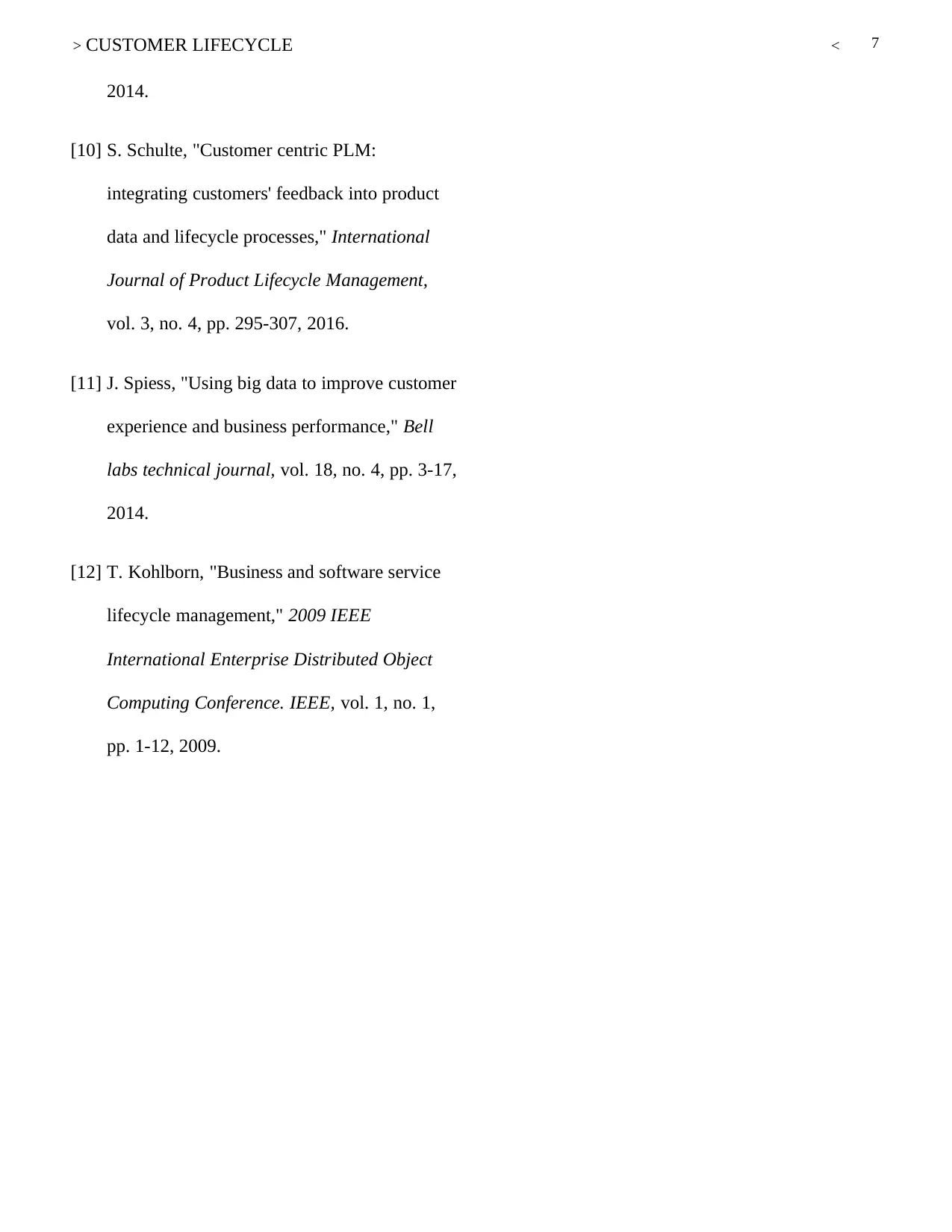
> CUSTOMER LIFECYCLE <
2014.
[10] S. Schulte, "Customer centric PLM:
integrating customers' feedback into product
data and lifecycle processes," International
Journal of Product Lifecycle Management,
vol. 3, no. 4, pp. 295-307, 2016.
[11] J. Spiess, "Using big data to improve customer
experience and business performance," Bell
labs technical journal, vol. 18, no. 4, pp. 3-17,
2014.
[12] T. Kohlborn, "Business and software service
lifecycle management," 2009 IEEE
International Enterprise Distributed Object
Computing Conference. IEEE, vol. 1, no. 1,
pp. 1-12, 2009.
7
2014.
[10] S. Schulte, "Customer centric PLM:
integrating customers' feedback into product
data and lifecycle processes," International
Journal of Product Lifecycle Management,
vol. 3, no. 4, pp. 295-307, 2016.
[11] J. Spiess, "Using big data to improve customer
experience and business performance," Bell
labs technical journal, vol. 18, no. 4, pp. 3-17,
2014.
[12] T. Kohlborn, "Business and software service
lifecycle management," 2009 IEEE
International Enterprise Distributed Object
Computing Conference. IEEE, vol. 1, no. 1,
pp. 1-12, 2009.
7
1 out of 7
Related Documents
Your All-in-One AI-Powered Toolkit for Academic Success.
+13062052269
info@desklib.com
Available 24*7 on WhatsApp / Email
![[object Object]](/_next/static/media/star-bottom.7253800d.svg)
Unlock your academic potential
© 2024 | Zucol Services PVT LTD | All rights reserved.





